| ________________
CM . . . . Volume XVIII Number 38 . . . . June 1, 2012

 |
Darius Gets Bullied. (Life with Darius, Book 1).
Cynthia Stella Peters. Illustrated by Robbie Taylor.
Windsor, ON: Hanna Books (www.hannabooksinc.vpweb.com), 2009-11.
24 pp., pbk., $10.00 plus shipping.
ISBN 978-0-9869305-1-5.
Preschool-grade 3 / Ages 4-8.
Review by Dave Jenkinson.
* /4
|
| |
|
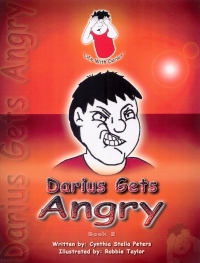 |
Darius Gets Angry. (Life with Darius, Book 2).
Cynthia Stella Peters. Illustrated by Robbie Taylor.
Windsor, ON: Hanna Books (www.hannabooksinc.vpweb.com), 2009-11.
26 pp., pbk., $10.00 plus shipping.
ISBN 978-0-9869305-2-2.
Preschool-grade 3 / Ages 4-8.
Review by Dave Jenkinson.
* /4
|
| |
|
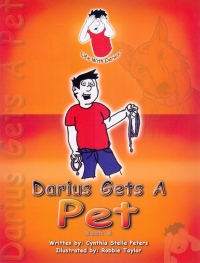 |
Darius Gets a Pet. (Life with Darius, Book 3).
Cynthia Stella Peters. Illustrated by Robbie Taylor.
Windsor, ON: Hanna Books (www.hannabooksinc.vpweb.com), 2009-11.
26 pp., pbk., $10.00 plus shipping.
ISBN 978-0-9869305-3-9.
Preschool-grade 3 / Ages 4-8.
Review by Dave Jenkinson.
* /4 |
| |
|
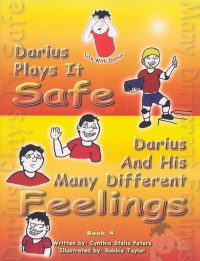 |
Darius Plays It Safe / Darius and His Many Different Feelings. (Life with Darius, Book 4).
Cynthia Stella Peters. Illustrated by Robbie Taylor.
Windsor, ON: Hanna Books (www.hannabooksinc.vpweb.com), 2009-12.
12 & 12 pp., pbk., $10.00 plus shipping.
ISBN 978-0-9869305-4-6.
Preschool-grade 3 / Ages 4-8.
Review by Dave Jenkinson.
* /4
|
| |
|
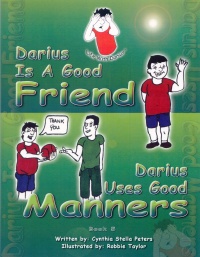 |
Darius Is a Good Friend / Darius Uses Good Manners. (Life with Darius, Book 5).
Cynthia Stella Peters. Illustrated by Robbie Taylor.
Windsor, ON: Hanna Books (www.hannabooksinc.vpweb.com), 2009-12.
12 & 16 pp., pbk., $10.00 plus shipping.
ISBN 978-0-9869305-6-0.
Preschool-grade 3 / Ages 4-8.
Review by Dave Jenkinson.
* /4 |
| |
|
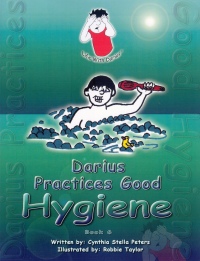 |
Darius Practices Good Hygiene. (Life with Darius, Book 6).
Cynthia Stella Peters. Illustrated by Robbie Taylor.
Windsor, ON: Hanna Books (www.hannabooksinc.vpweb.com), 2009-12.
20 pp., pbk., $10.00 plus shipping.
ISBN 978-0-9869305-7-7.
Preschool-grade 3 / Ages 4-8.
Review by Dave Jenkinson.
* /4 |
| |
|
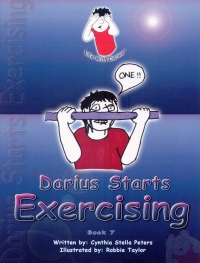 |
Darius Starts Exercising. (Life with Darius, Book 7).
Cynthia Stella Peters. Illustrated by Robbie Taylor.
Windsor, ON: Hanna Books (www.hannabooksinc.vpweb.com), 2009-12.
18 pp., pbk., $10.00 plus shipping.
ISBN 978-0-9869305-9-1.
Preschool-grade 3 / Ages 4-8.
Review by Dave Jenkinson.
* /4
|
| |
|
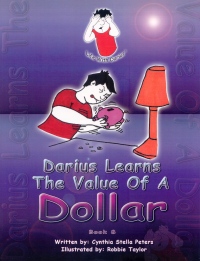 |
Darius Learns the Value of a Dollar. (Life with Darius, Book 8).
Cynthia Stella Peters. Illustrated by Robbie Taylor.
Windsor, ON: Hanna Books (www.hannabooksinc.vpweb.com), 2009-12.
20 pp., pbk., $10.00 plus shipping.
ISBN 978-0-9877636-0-0.
Grades 5-8 / Ages 10-13.
Review by Dave Jenkinson.
* /4
|
| |
|

excerpts:
Darius couldn't handle the teasing anymore. He put his hands to his forehead and shouted "I don't know what to do!"
The teacher said "Darius, do you need some help?" Darius saw Billy making a fist at him, he felt very afraid, but he knew he had to do something.
Darius decided not to tell the teacher at that moment, but did tell the teacher at the end of the day when no one else was around.
Darius explained everything that Billy was doing to him, and to others as well. "It's not just me that he bullies. He picks on the new girl with the accent and the boy with the turban on his head. He picks on anyone that doesn't look like him or act like him," Darius told his teacher. (From Darius Gets Bullied.)
If you're going to write a series of "teaching" books that revolve around the same character and you are going to direct that series at a preschool/early school audience, then it is essential that your continuing character connects on an emotional level with the intended target audience. Paulette Bourgeois and Brenda Clark's "Franklin" stories proved that it could be done, and the little turtle's multifaceted character and his various "predicaments" resonated with youngsters who could identify with Franklin.
The same claim to reader resonance, unfortunately, cannot be said of Darius. The logo for the eight books in the "Life with Darius" series portrays a young boy with his two hands reaching for his forehead/hairline. The front page of every book in the series (twice in the volumes with two parts) repeats the information that the author's "husband often puts his hands to his forehead when Cynthia [the author] does something silly as Darius does in each book. This is how the Darius Series was born." Although the logo has a certain "cuteness" to it and the motivation for Darius's gesture is left open for reader conjecture, there is really no further development of Darius' personality other than what is temporarily necessary for the unrolling of the content of a particular book in the series. It is not until the double-barreled stories in Book 4 that readers first learn in Part II Darius and His Many Different Feelings (p. 3) that Darius has a brother. The brother's name is not provided nor does Peters make clear whether this brother is older or younger than Darius. On p. 10 of the same story, readers are told that Darius has "older siblings [who] don't want to play with him." Again, names, ages and gender of these siblings are unreported, and they never appear in any of the stories, not even in Book 5 Part II, Darius Uses Good Manners, in which the text reads: "Once dinner was cooked, the family sat down to eat." The only juvenile family member who appears in Taylor's dinner illustrations is Darius.
Though the text says that "Darius is a young boy...." (Darius and His Many Different Feelings), p. 9), Peters does not make his age explicit. Readers do know that Darius attends school and that he can read or write. Readers might be able to guess Darius' approximate age by comparing Darius' size with objects and other characters around him. Most unfortunately, Taylor
is quite inconsistent in how she draws Darius. Assuming that readers read the books in numerical order, the first time readers meet Darius on p. 1 in Book 1, Darius Gets Bullied, his body proportions suggest he could be young enough to be in kindergarten or grade 1; however, by p. 3, Taylor's rendition makes Darius look much older, and, in some of the later books, Darius is big enough that he could even be a teenager. Overall, Taylor's cartoon-like illustrations, while present on every page, are amateurish and contribute little to the books's contents.
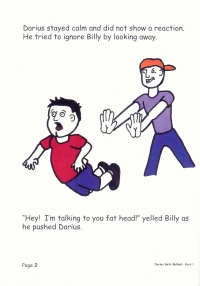 Darius Gets Bullied, the first book in the series, is the closest that any of the books actually get to having a real plot. Billy, who is bigger than Darius, begins to bully Darius on the playground. Billy calls Darius "fatso' before pushing him to the ground and then kicking him in the leg and spitting on him. The bullying continues in the classroom as Billy steals Darius' homework and then taunts him when Darius has to redo his homework while the other students got to play computer games. Finally, as the end of the school day, Darius confides in his teacher [see "excerpt" above]. When the teacher asks Darius, "Did you try to make [Billy] stop?", Darius responds positively and then spontaneously writes on the blackboard the eight "steps that we have learned in school" for dealing with bullies. The next day, the teacher calls Billy in after class and suspends him from school for three days and adds further consequences, including removing Billy from the basketball team. "When Billy returned to school, he apologized to all the children and never bothered them again." Would that bullying situations in the real world find such quick solutions.
Darius Gets Bullied, the first book in the series, is the closest that any of the books actually get to having a real plot. Billy, who is bigger than Darius, begins to bully Darius on the playground. Billy calls Darius "fatso' before pushing him to the ground and then kicking him in the leg and spitting on him. The bullying continues in the classroom as Billy steals Darius' homework and then taunts him when Darius has to redo his homework while the other students got to play computer games. Finally, as the end of the school day, Darius confides in his teacher [see "excerpt" above]. When the teacher asks Darius, "Did you try to make [Billy] stop?", Darius responds positively and then spontaneously writes on the blackboard the eight "steps that we have learned in school" for dealing with bullies. The next day, the teacher calls Billy in after class and suspends him from school for three days and adds further consequences, including removing Billy from the basketball team. "When Billy returned to school, he apologized to all the children and never bothered them again." Would that bullying situations in the real world find such quick solutions.
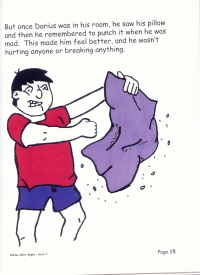 In the next book, Darius Gets Angry, Darius' mother observes him falling off his skateboard and throwing his skateboard away in anger. She tells him that his response to his falling is inappropriate and asks him to recall "some of the steps I taught you to control angry feelings." Darius remembers that she had suggested counting to 10 and taking deep breaths, and, if these two actions didn't help and he still felt like throwing or hitting something, he could always punch his pillow. The next day, however, the anger-response lesson is forgotten, and Darius' angry behaviour gets him sent to his room where he angrily punches his pillow. Mom follows up and asks Darius to, in the future, consider what is making him angry and to ask himself what he could have done differently instead of becoming angry. She also adds the suggestion of taking a walk or running on a treadmill "to work off the energy" that the emotion of anger can generate. By book's end, Darius was better at controlling his anger, and "whenever Darius handled his anger well, he often got a few extra minutes on his video games for making the right choices."
In the next book, Darius Gets Angry, Darius' mother observes him falling off his skateboard and throwing his skateboard away in anger. She tells him that his response to his falling is inappropriate and asks him to recall "some of the steps I taught you to control angry feelings." Darius remembers that she had suggested counting to 10 and taking deep breaths, and, if these two actions didn't help and he still felt like throwing or hitting something, he could always punch his pillow. The next day, however, the anger-response lesson is forgotten, and Darius' angry behaviour gets him sent to his room where he angrily punches his pillow. Mom follows up and asks Darius to, in the future, consider what is making him angry and to ask himself what he could have done differently instead of becoming angry. She also adds the suggestion of taking a walk or running on a treadmill "to work off the energy" that the emotion of anger can generate. By book's end, Darius was better at controlling his anger, and "whenever Darius handled his anger well, he often got a few extra minutes on his video games for making the right choices."
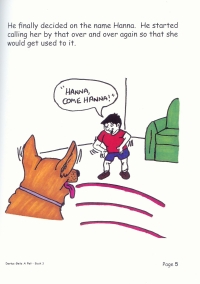
The series' third volume, Darius Gets a Pet, finds Darius and his parents at the "Animal Rescue Shelter" where Darius selects a "German Shepherd with a mix of Collie", and he names her Hanna. Each morning, Darius gives Hanna fresh food and water and takes "her outside to train her to use the dog pen as her bathroom." He also walks her daily and teaches her tricks. Darius discovers that having a dog is not all fun and games, and he faithfully carries out his responsibility of cleaning up the dog poop in the pen. He also faithfully bathes and grooms Hanna. With his father's assistance, Darius constructs a dog house for Hanna. As this book is essentially plotless, it just stumbles to a conclusion.
The next two books in the series actually each contain two unconnected stories. In Book 4's first "story", Darius Plays It Safe, a helmeted Darius is riding his bike on the sidewalk [emphasis mine] when a stranger tries to lure him into a car. Darius, "knowing he wasn't supposed to talk to strangers..." seeks safety at a neighbour's house. 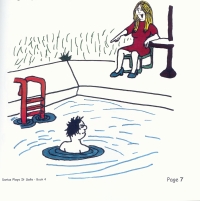 His mother picks him up from there in her truck, and Darius "put on his seatbelt to be safe." At home, "he wanted to play in the pool", but his mother insisted that she be present and that he stay in the shallow end. "Being supervised by an adult is a safe way to swim." More safety examples involve pots on stoves, answering the telephone when parents aren't home and communicating on the computer. This portion of Book 4 ends with a "COLOR ME!" page which is a reproduction, sans colour, of the illustration in which Darius' mother picked him up from the neighbour's house. In the second half of Book 4, Darius and His Many Different Feelings, Darius is shown to be shy, angry, happy, sad, afraid, nervous, confused, silly, lonely and guilty. Again, there is no plot. His mother picks him up from there in her truck, and Darius "put on his seatbelt to be safe." At home, "he wanted to play in the pool", but his mother insisted that she be present and that he stay in the shallow end. "Being supervised by an adult is a safe way to swim." More safety examples involve pots on stoves, answering the telephone when parents aren't home and communicating on the computer. This portion of Book 4 ends with a "COLOR ME!" page which is a reproduction, sans colour, of the illustration in which Darius' mother picked him up from the neighbour's house. In the second half of Book 4, Darius and His Many Different Feelings, Darius is shown to be shy, angry, happy, sad, afraid, nervous, confused, silly, lonely and guilty. Again, there is no plot.
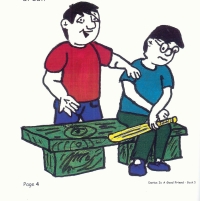 Book 5 begins with "Darius is a Good Friend" in which Darius share his baseball bat with a friend. He also apologizes for hurting a friend's feelings by criticizing how the friend threw a ball. During the game, Darius supports his teammates by praising and encouraging them. When the friend to whom Darius had loaned his bat accidentally breaks it while batting, "[Darius] stayed calm and did not yell at him." More examples of Darius' being a good friend are provided, and readers learn that "By doing nice things, Darius has become very popular and has many friends." This "story" also has a "COLOR ME!" page at the end. In Darius Uses Good Manners, Darius helps an elderly woman across the street, gives up his seat on the bus to "an older gentleman with a cane", holds open the grocery store door for others, restacks some cans he accidentally knocked over, apologizes to someone he bumps into, picks up some coins that had been dropped, helps his mother bring the groceries into the house, eats with a knife and fork and not his fingers, and chews with his mouth closed, says "please" and "thank you" as well as "excuse me" when he burps. Lots of things happen, but, again, there is no story.
Book 5 begins with "Darius is a Good Friend" in which Darius share his baseball bat with a friend. He also apologizes for hurting a friend's feelings by criticizing how the friend threw a ball. During the game, Darius supports his teammates by praising and encouraging them. When the friend to whom Darius had loaned his bat accidentally breaks it while batting, "[Darius] stayed calm and did not yell at him." More examples of Darius' being a good friend are provided, and readers learn that "By doing nice things, Darius has become very popular and has many friends." This "story" also has a "COLOR ME!" page at the end. In Darius Uses Good Manners, Darius helps an elderly woman across the street, gives up his seat on the bus to "an older gentleman with a cane", holds open the grocery store door for others, restacks some cans he accidentally knocked over, apologizes to someone he bumps into, picks up some coins that had been dropped, helps his mother bring the groceries into the house, eats with a knife and fork and not his fingers, and chews with his mouth closed, says "please" and "thank you" as well as "excuse me" when he burps. Lots of things happen, but, again, there is no story.
 In the sixth volume, Darius Practices Good Hygiene, readers follow Darius through a day as he first goes through his morning ablutions. Readers are told on page 1 that "[w]hen Darius wakes up in the morning, he washes his hands and face, and then brushes his teeth." On pages 2 & 3, the same information is repeated, but in more detail. Dressing in clean clothes for the day follows next. Interestingly, Darius has breakfast, but he does not appear to re-brush his teeth. Playing outside is followed by more hand washing which needs to be repeated after Darius uses the toilet. When Joe, a friend, comes over to play and wipes his runny nose on his sleeve, Darius gives him a tissue, and, when Joe sneezes without covering his face, Darius sends him home "since he was sick with a cold." Not wanting to catch the cold himself, Darius heads back to the bathroom to wash his hands yet again. The book does not mention lunch, but dinner, aka supper, is followed by teeth brushing and a bath. The book ends with another "COLOR ME!" page.
In the sixth volume, Darius Practices Good Hygiene, readers follow Darius through a day as he first goes through his morning ablutions. Readers are told on page 1 that "[w]hen Darius wakes up in the morning, he washes his hands and face, and then brushes his teeth." On pages 2 & 3, the same information is repeated, but in more detail. Dressing in clean clothes for the day follows next. Interestingly, Darius has breakfast, but he does not appear to re-brush his teeth. Playing outside is followed by more hand washing which needs to be repeated after Darius uses the toilet. When Joe, a friend, comes over to play and wipes his runny nose on his sleeve, Darius gives him a tissue, and, when Joe sneezes without covering his face, Darius sends him home "since he was sick with a cold." Not wanting to catch the cold himself, Darius heads back to the bathroom to wash his hands yet again. The book does not mention lunch, but dinner, aka supper, is followed by teeth brushing and a bath. The book ends with another "COLOR ME!" page.
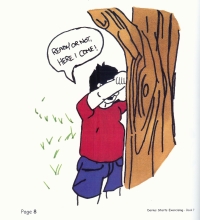
In Darius Starts Exercising, the seventh volume in the series, Darius "has started to notice a change in his body from not being active enough." He also remembers that the playground bully called him Fatso, a happening that occurred in the first volume of the series. Though Darius recalls being taught in school that weight loss results from a combination of increased exercise and eating right, the contents of this volume focus more on the former as Darius engages in increased outdoor play activities with friends plus more active indoor behaviors, such as dancing to the music on his MP3 player. Another "COLOR ME!" page brings this book to an end.
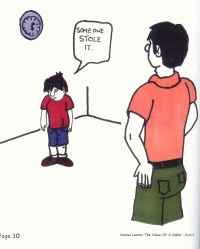 Darius Learns the Value of a Dollar, the final volume in the series, sees Darius forgetting to bring his skateboard into the house when his mother calls him in for dinner. After the meal, he finds that his skateboard has disappeared from the yard. When Darius reports to his parents that his skateboard was missing, his father replies that "...you have to learn to put things away. Now someone stole your skateboard." Knowing that "his parents didn't have extra money to buy him a new skateboard", Darius asks his father what he could do to earn enough money to purchase another skateboard. His father suggests cutting neighbours' grass or getting a paper route, and Darius does both. This title contains a number of "call-backs" to earlier books in the series. For example, "Darius asked his parents politely if he could be excused from the table" (Darius Uses Good Manners while the theft of the skateboard "made Darius very angry, but he did not yell at anyone" (Darius Gets Angry). Even Billy, the "villain" from Darius Gets Bullied, makes an appearance, and his taunting knowledge of the theft of the skateboard makes him a prime suspect in its disappearance.
Darius Learns the Value of a Dollar, the final volume in the series, sees Darius forgetting to bring his skateboard into the house when his mother calls him in for dinner. After the meal, he finds that his skateboard has disappeared from the yard. When Darius reports to his parents that his skateboard was missing, his father replies that "...you have to learn to put things away. Now someone stole your skateboard." Knowing that "his parents didn't have extra money to buy him a new skateboard", Darius asks his father what he could do to earn enough money to purchase another skateboard. His father suggests cutting neighbours' grass or getting a paper route, and Darius does both. This title contains a number of "call-backs" to earlier books in the series. For example, "Darius asked his parents politely if he could be excused from the table" (Darius Uses Good Manners while the theft of the skateboard "made Darius very angry, but he did not yell at anyone" (Darius Gets Angry). Even Billy, the "villain" from Darius Gets Bullied, makes an appearance, and his taunting knowledge of the theft of the skateboard makes him a prime suspect in its disappearance.
Children's literature has always been used to entertain and to inform. On the back cover of each of the books in the Darius series, a note informs potential purchasers that "Cynthia designed these books for a very young age group in hopes of teaching children these life lessons as early as possible." Too often, however, authors, in their zeal to inform or teach children, forget the entertainment component. Simply put, the eight books in the "Life With Darius" series have almost completely overlooked the entertainment aspect. Most of the "stories" are not stories; they are simply listings of things that Darius, the central character, is doing, and a list does not constitute a plot.
Not recommended.
Dave Jenkinson, CM's editor, lives in Winnipeg, MB.

To comment
on this title or this review, send mail to cm@umanitoba.ca.
Copyright © the Manitoba Library Association. Reproduction for personal
use is permitted only if this copyright notice is maintained. Any
other reproduction is prohibited without permission.
NEXT REVIEW |
TABLE OF CONTENTS FOR THIS ISSUE
- June 1, 2012.
AUTHORS |
TITLES |
MEDIA REVIEWS |
PROFILES |
BACK ISSUES |
SEARCH |
CMARCHIVE |
HOME |








 Darius Gets Bullied, the first book in the series, is the closest that any of the books actually get to having a real plot. Billy, who is bigger than Darius, begins to bully Darius on the playground. Billy calls Darius "fatso' before pushing him to the ground and then kicking him in the leg and spitting on him. The bullying continues in the classroom as Billy steals Darius' homework and then taunts him when Darius has to redo his homework while the other students got to play computer games. Finally, as the end of the school day, Darius confides in his teacher [see "excerpt" above]. When the teacher asks Darius, "Did you try to make [Billy] stop?", Darius responds positively and then spontaneously writes on the blackboard the eight "steps that we have learned in school" for dealing with bullies. The next day, the teacher calls Billy in after class and suspends him from school for three days and adds further consequences, including removing Billy from the basketball team. "When Billy returned to school, he apologized to all the children and never bothered them again." Would that bullying situations in the real world find such quick solutions.
Darius Gets Bullied, the first book in the series, is the closest that any of the books actually get to having a real plot. Billy, who is bigger than Darius, begins to bully Darius on the playground. Billy calls Darius "fatso' before pushing him to the ground and then kicking him in the leg and spitting on him. The bullying continues in the classroom as Billy steals Darius' homework and then taunts him when Darius has to redo his homework while the other students got to play computer games. Finally, as the end of the school day, Darius confides in his teacher [see "excerpt" above]. When the teacher asks Darius, "Did you try to make [Billy] stop?", Darius responds positively and then spontaneously writes on the blackboard the eight "steps that we have learned in school" for dealing with bullies. The next day, the teacher calls Billy in after class and suspends him from school for three days and adds further consequences, including removing Billy from the basketball team. "When Billy returned to school, he apologized to all the children and never bothered them again." Would that bullying situations in the real world find such quick solutions.
 In the next book, Darius Gets Angry, Darius' mother observes him falling off his skateboard and throwing his skateboard away in anger. She tells him that his response to his falling is inappropriate and asks him to recall "some of the steps I taught you to control angry feelings." Darius remembers that she had suggested counting to 10 and taking deep breaths, and, if these two actions didn't help and he still felt like throwing or hitting something, he could always punch his pillow. The next day, however, the anger-response lesson is forgotten, and Darius' angry behaviour gets him sent to his room where he angrily punches his pillow. Mom follows up and asks Darius to, in the future, consider what is making him angry and to ask himself what he could have done differently instead of becoming angry. She also adds the suggestion of taking a walk or running on a treadmill "to work off the energy" that the emotion of anger can generate. By book's end, Darius was better at controlling his anger, and "whenever Darius handled his anger well, he often got a few extra minutes on his video games for making the right choices."
In the next book, Darius Gets Angry, Darius' mother observes him falling off his skateboard and throwing his skateboard away in anger. She tells him that his response to his falling is inappropriate and asks him to recall "some of the steps I taught you to control angry feelings." Darius remembers that she had suggested counting to 10 and taking deep breaths, and, if these two actions didn't help and he still felt like throwing or hitting something, he could always punch his pillow. The next day, however, the anger-response lesson is forgotten, and Darius' angry behaviour gets him sent to his room where he angrily punches his pillow. Mom follows up and asks Darius to, in the future, consider what is making him angry and to ask himself what he could have done differently instead of becoming angry. She also adds the suggestion of taking a walk or running on a treadmill "to work off the energy" that the emotion of anger can generate. By book's end, Darius was better at controlling his anger, and "whenever Darius handled his anger well, he often got a few extra minutes on his video games for making the right choices."

 His mother picks him up from there in her truck, and Darius "put on his seatbelt to be safe." At home, "he wanted to play in the pool", but his mother insisted that she be present and that he stay in the shallow end. "Being supervised by an adult is a safe way to swim." More safety examples involve pots on stoves, answering the telephone when parents aren't home and communicating on the computer. This portion of Book 4 ends with a "COLOR ME!" page which is a reproduction, sans colour, of the illustration in which Darius' mother picked him up from the neighbour's house. In the second half of Book 4, Darius and His Many Different Feelings, Darius is shown to be shy, angry, happy, sad, afraid, nervous, confused, silly, lonely and guilty. Again, there is no plot.
His mother picks him up from there in her truck, and Darius "put on his seatbelt to be safe." At home, "he wanted to play in the pool", but his mother insisted that she be present and that he stay in the shallow end. "Being supervised by an adult is a safe way to swim." More safety examples involve pots on stoves, answering the telephone when parents aren't home and communicating on the computer. This portion of Book 4 ends with a "COLOR ME!" page which is a reproduction, sans colour, of the illustration in which Darius' mother picked him up from the neighbour's house. In the second half of Book 4, Darius and His Many Different Feelings, Darius is shown to be shy, angry, happy, sad, afraid, nervous, confused, silly, lonely and guilty. Again, there is no plot.
 Book 5 begins with "Darius is a Good Friend" in which Darius share his baseball bat with a friend. He also apologizes for hurting a friend's feelings by criticizing how the friend threw a ball. During the game, Darius supports his teammates by praising and encouraging them. When the friend to whom Darius had loaned his bat accidentally breaks it while batting, "[Darius] stayed calm and did not yell at him." More examples of Darius' being a good friend are provided, and readers learn that "By doing nice things, Darius has become very popular and has many friends." This "story" also has a "COLOR ME!" page at the end. In Darius Uses Good Manners, Darius helps an elderly woman across the street, gives up his seat on the bus to "an older gentleman with a cane", holds open the grocery store door for others, restacks some cans he accidentally knocked over, apologizes to someone he bumps into, picks up some coins that had been dropped, helps his mother bring the groceries into the house, eats with a knife and fork and not his fingers, and chews with his mouth closed, says "please" and "thank you" as well as "excuse me" when he burps. Lots of things happen, but, again, there is no story.
Book 5 begins with "Darius is a Good Friend" in which Darius share his baseball bat with a friend. He also apologizes for hurting a friend's feelings by criticizing how the friend threw a ball. During the game, Darius supports his teammates by praising and encouraging them. When the friend to whom Darius had loaned his bat accidentally breaks it while batting, "[Darius] stayed calm and did not yell at him." More examples of Darius' being a good friend are provided, and readers learn that "By doing nice things, Darius has become very popular and has many friends." This "story" also has a "COLOR ME!" page at the end. In Darius Uses Good Manners, Darius helps an elderly woman across the street, gives up his seat on the bus to "an older gentleman with a cane", holds open the grocery store door for others, restacks some cans he accidentally knocked over, apologizes to someone he bumps into, picks up some coins that had been dropped, helps his mother bring the groceries into the house, eats with a knife and fork and not his fingers, and chews with his mouth closed, says "please" and "thank you" as well as "excuse me" when he burps. Lots of things happen, but, again, there is no story.
 In the sixth volume, Darius Practices Good Hygiene, readers follow Darius through a day as he first goes through his morning ablutions. Readers are told on page 1 that "[w]hen Darius wakes up in the morning, he washes his hands and face, and then brushes his teeth." On pages 2 & 3, the same information is repeated, but in more detail. Dressing in clean clothes for the day follows next. Interestingly, Darius has breakfast, but he does not appear to re-brush his teeth. Playing outside is followed by more hand washing which needs to be repeated after Darius uses the toilet. When Joe, a friend, comes over to play and wipes his runny nose on his sleeve, Darius gives him a tissue, and, when Joe sneezes without covering his face, Darius sends him home "since he was sick with a cold." Not wanting to catch the cold himself, Darius heads back to the bathroom to wash his hands yet again. The book does not mention lunch, but dinner, aka supper, is followed by teeth brushing and a bath. The book ends with another "COLOR ME!" page.
In the sixth volume, Darius Practices Good Hygiene, readers follow Darius through a day as he first goes through his morning ablutions. Readers are told on page 1 that "[w]hen Darius wakes up in the morning, he washes his hands and face, and then brushes his teeth." On pages 2 & 3, the same information is repeated, but in more detail. Dressing in clean clothes for the day follows next. Interestingly, Darius has breakfast, but he does not appear to re-brush his teeth. Playing outside is followed by more hand washing which needs to be repeated after Darius uses the toilet. When Joe, a friend, comes over to play and wipes his runny nose on his sleeve, Darius gives him a tissue, and, when Joe sneezes without covering his face, Darius sends him home "since he was sick with a cold." Not wanting to catch the cold himself, Darius heads back to the bathroom to wash his hands yet again. The book does not mention lunch, but dinner, aka supper, is followed by teeth brushing and a bath. The book ends with another "COLOR ME!" page.

 Darius Learns the Value of a Dollar, the final volume in the series, sees Darius forgetting to bring his skateboard into the house when his mother calls him in for dinner. After the meal, he finds that his skateboard has disappeared from the yard. When Darius reports to his parents that his skateboard was missing, his father replies that "...you have to learn to put things away. Now someone stole your skateboard." Knowing that "his parents didn't have extra money to buy him a new skateboard", Darius asks his father what he could do to earn enough money to purchase another skateboard. His father suggests cutting neighbours' grass or getting a paper route, and Darius does both. This title contains a number of "call-backs" to earlier books in the series. For example, "Darius asked his parents politely if he could be excused from the table" (Darius Uses Good Manners while the theft of the skateboard "made Darius very angry, but he did not yell at anyone" (Darius Gets Angry). Even Billy, the "villain" from Darius Gets Bullied, makes an appearance, and his taunting knowledge of the theft of the skateboard makes him a prime suspect in its disappearance.
Darius Learns the Value of a Dollar, the final volume in the series, sees Darius forgetting to bring his skateboard into the house when his mother calls him in for dinner. After the meal, he finds that his skateboard has disappeared from the yard. When Darius reports to his parents that his skateboard was missing, his father replies that "...you have to learn to put things away. Now someone stole your skateboard." Knowing that "his parents didn't have extra money to buy him a new skateboard", Darius asks his father what he could do to earn enough money to purchase another skateboard. His father suggests cutting neighbours' grass or getting a paper route, and Darius does both. This title contains a number of "call-backs" to earlier books in the series. For example, "Darius asked his parents politely if he could be excused from the table" (Darius Uses Good Manners while the theft of the skateboard "made Darius very angry, but he did not yell at anyone" (Darius Gets Angry). Even Billy, the "villain" from Darius Gets Bullied, makes an appearance, and his taunting knowledge of the theft of the skateboard makes him a prime suspect in its disappearance.